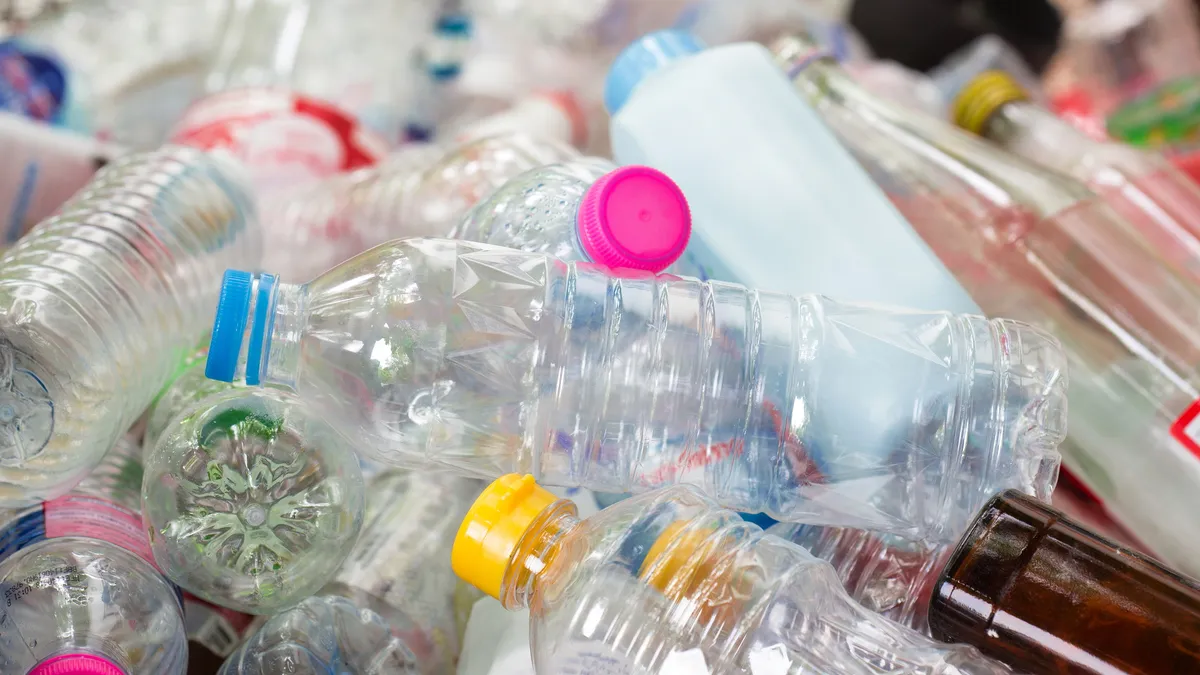Dive Brief:
- The U.S. Plastics Pact, a consortium of public and private stakeholders working toward a circular economy for plastic, released a new resource designed to educate the packaging industry on postconsumer recycled content.
- The PCR Toolkit contains information on topics such as incorporating PCR into food-grade applications, finding a PCR supplier, and complying with labeling requirements.
- USPP debuted the open-source guide at last week’s Plastics Recycling Conference, where many discussions spotlighted the current challenges with maintaining consistent supply and demand in the PCR market.
Dive Insight:
Pact participants are aiming to have an average of 30% recycled content in their plastic packaging by 2025, thereby decreasing reliance on virgin resin. Yet the most recently available data from the group shows an average level of post-consumer recycled content or “responsibly sourced biobased content” around 8%.
“PCR procurement is complex, and the U.S. Pact aims to provide clarity with this Toolkit so that more plastic packaging producers can incorporate it into their products,” the USPP toolkit announcement states.
In recent years, many companies made commitments about product or packaging recycling, composting or reuse, said Director of Strategy and Engagement Crystal Bayliss during a USPP workshop at the conference on March 7. Fewer made specific commitments regarding PCR use, and USPP is trying to change that.
“Ultimately, if companies are just designing things to be recyclable but not using recycled content, all that's going to happen is we're going to tank PCR prices” and likely a lot of that material ends up at the landfill, “which is not helping the situation,” Bayliss said. “So it's really important that brand owners understand this and they're making the commitments to close that circle to make sure that postconsumer recycled content makes it back into our products.”
Bayliss, whose background prior to USPP was in procurement, noted the myriad questions procurement leaders and R&D teams face with sourcing and implementing recycled material in products. One key question is about securing supply and whether a brand will be able to meet PCR claims that might actually be printed on labeling. Others pertain to visibility and understanding of the cost drivers of material, how costs could be lowered and whether there could be competition for supplier contracts.
A panel of speakers during the workshop noted possible solutions. To establish greater reliability in the recycled content market, Association of Plastic Recyclers CEO Steve Alexander called for long-term contracts.
Eadaoin Quinn, sustainable packaging senior manager, Americas, at Mars — which, like APR, is among the U.S. Plastics Pact activators — said industry participants like converters and MRFs ought to be more assertive in offering PCR and in sharing ideas about where and how to use PCR.
“I think we do have to kind of break down our traditional expectations of where it could go and start thinking outside of the box. So if you have any ideas of where it can be used, and you're really passionate about it, that's an easy win, I think we need to just be sharing those ideas,” Quinn said. “Because it is something that we've kind of put out there: ‘We want to buy PCR; what do you have available?’ ... Sometimes we get crickets in response.”
Quinn also noted heightened challenges with securing food-grade PCR, which she said is in lower supply than non-food-grade PCR. “It's a bit of a puzzle of figuring out how we match the supply and demand gap.”
At the outset of the workshop, USPP Executive Director Emily Tipaldo discussed the importance of data-sharing and case studies, some of which were in the 2021 annual report USPP released last month. The report suggested that certain 2025 targets are unlikely to be met on time.
In a separate conference panel on March 6, recycling market analysts discussed how the news from the USPP report about potentially missing targets could light a fire under brands. They also suggested that future standards outside of voluntary commitments provide reason for optimism.










